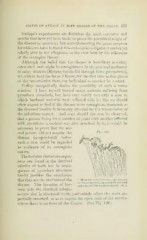Page 355 - My FlipBook
P. 355
POIMS OF ATTACK JX SOFT TISSUES OF THE MOUTH. 327
Galippe's experiments are doubtless the most extensive and
careful that have vet been made to prove the parasitical origin of
the disease in question; but notwithstanding the great progress
for which we have to thank this eminent investigator, I cannot vet
Avholly give in my allegiance to the view held by the adherents
of the contagion theory.
Although the belief that the disease is hereditary is widely
circulated, and might be strengthened by the personal testimony
of many dentists (Morgan watched it through three generations),
we seldom hear (as far as I know, for the first time in this place)
of the transmission from one individual to another by contact.
Pedley energetically denies the possibility of such a trans-
mission. I have myself treated many patients suffering from
pyorrhcea alveolaris, but have very rarely met with a case in
which husband and wife were alliicted witii it ; this we sliould
often expect to find if the disease were contagious, inasmuch as
the diseased locality is favorably situated for the transmission of
the infectious matter. And even sliould the case be observed,
that a person li\dng for a nuinber of years with another afiiicted
with pyorrhoea alveolaris was also attacked by it, it would be
necessary to prove that the sec-
ond person did not acquire the ^f"- ^-^
disease independentlv before /iste^^,. ^-*=%e..
such a case could be regarded ,&«' vn i W^v '"^ - ••'
as evidence of its contagious
\\ K'f^}^^^^^-^^^.^
nature.
The fact also that micro-organ-
isms are found in the dentinal "4V!lV'>
tubules of teeth lost in conse- \w ii*it,wv
quence of pyorrha'a alveolaris
v\ • ' ' i'\\\\Vr'
hardly justifies the conclusion \ V^'^iWWVifplpW''' v.
that thev are the excitants of the ' Micrococci pesktrating thk Canals
,. " rr\\ • • i? 1 OF Solid Dextixk, in a partially absorbed
disease. ine invasion Ot bac-
and abscessed but not decayed root. 700:1.
teria into the dentinal tubules
occurs also in abscessed teeth, particularly when the roots are
partially resorbed, so as to expose the open ends of the tubules
where there is no trace of the disease. (See Fig. 120.)


